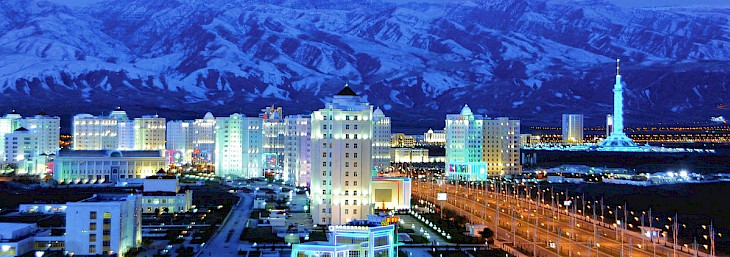Turkmenistan is a country located in Central Asia, bordered by Kazakhstan to the north, Uzbekistan to the north, east and northeast, Afghanistan to the southeast, Iran to the south and southwest and the Caspian Sea to the west.
Ashgabat is the capital and largest city with a population of approximately 900,000 people. The Turkmen capital became the Guinness book record holder for the number of buildings made of white marble.
The population is about 6 million, the lowest of the Central Asian republics, and Turkmenistan is one of the most sparsely populated nations in Asia.
The territory of the country is spread over 491,200 sq. km. The lands of Turkmenistan are 80% represented by deserts. Most of the country is covered by the Karakum Desert.
Turkmenistan possesses the world's fifth largest reserves of natural gas. From 1993 to 2017, citizens received government-provided electricity, water and natural gas free of charge.
Turkmenistan also specializes in cotton growing.
The national currency is Manat.
Turkmenistan is an observer state in the Organisation of Turkic States, the Türksoy community and a member of the United Nations. It is also the only permanent neutral country recognized by the UN General Assembly in Asia.
After over a century of being a part of the Russian Empire and then the Soviet Union (including 67 years as a union republic), Turkmenistan declared its independence on 27 October 1991, following the dissolution of the Soviet Union.
The country was ruled by President for Life Saparmurat Niyazov until his death on 21 December 2006. Presidential elections were held on 11 February 2007. Gurbanguly Berdimuhammedov was declared the winner with 89% of the vote. He was sworn in on 14 February 2007, and has been re-elected twice since, in 2012 and 2017. Early presidential elections were announced in February 2022 and Gurbanguly Berdimuhammedov announced that be he would not be running. His son Serdar’s candidacy was announced days later. He won the election with more than 70 percent of the vote and took over as president a week later.
The politics of Turkmenistan take place in the framework of a presidential republic, with the President both head of state and head of government. Under Niyazov, Turkmenistan had a one-party system; however, in September 2008, the People's Council unanimously passed a resolution adopting a new Constitution. The latter resulted in the abolition of the council and a significant increase in the size of Parliament in December 2008 and also permits the formation of multiple political parties.

